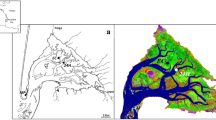Abstract
Water temperature, dissolved oxygen (DO), pH, and specific conductivity (spc) were measured in a time interval of 15 min in a karst spring and the spring-fed pool with flourishing submerged plants in Guilin, SW China under dry weather for periods of 2 days. Measurements allowed calculation of calcium and bicarbonate concentrations ([Ca2+] and [HCO3 −]), and thus CO2 partial pressure ( \( P_{{{\text{CO}}_{2} }} \)) and saturation index of calcite (SIc). Results show that there were not any diurnal variations in the physico-chemical parameters of the water for the spring. However, during daytime periods, pool water \( P_{{{\text{CO}}_{2} }} \) decreased to far less than the spring water in a few hours, pH and SIc increased to greater than the spring, and [Ca2+] and [HCO3 −] decreased to less than the spring. During nighttime periods, pool water \( P_{{{\text{CO}}_{2} }} \) returned to or even increased to greater than the spring, pH and SIc decreased to less than the spring, and [Ca2+] and [HCO3 −] increased to greater than the spring. The decrease in [Ca2+] and [HCO3 −] to less than the spring during daytime periods implies daytime deposition of calcium carbonate, while the increase in [Ca2+] and [HCO3 −] to greater than the spring during nighttime periods implies nighttime dissolution of calcium carbonate. The direction of the observed changes depended essentially on the illumination, indicating that daytime photosynthetic and nighttime respiratory activities in the pool aquatic plant ecosystem, which were further evidenced by the increase and decrease in DO during daytime and nighttime periods respectively, were the main processes involved. The large variations of the components of the carbonate system imply considerable changes of the capacities of CO2 and O2 in water. The finding has implications for water sampling strategy in slow-flowing karst streams and other similar environments with stagnant water bodies such as estuaries, lakes, reservoirs, and wetlands, where aquatic plant ecosystem may flourish.






Similar content being viewed by others
References
Andrews JE (2006) Paleoclimatic records from stable isotopes in riverine tufas: synthesis and review. Earth Sci Rev 75:85–104
Cicerone DS, Stewart AJ, Roh Y (1999) Diel cycles in calcite production and dissolution in a eutrophic basin. Environ Toxicol Chem 18:2169–2177
Drysdale R, Lucas S, Carthew K (2003) The influence of diurnal temperatures on the hydrochemistry of a tufa-depositing stream. Hydrol Process 17:3421–3441
Dupraz C, Visscher PT (2005) Microbial lithification in marine stromatolites and hypersaline mats. Trends Microbiol 13:429–438
Fuller CC, Davis JA (1989) Influence of coupling of sorption and photosynthetic processes on trace element cycles in natural waters. Nature 340:52–54
Gombert P (2002) Role of karstic dissolution in global carbon cycle. Glob Planet Change 33:177–184
Guasch H, Armengol J, Martí E, Sabater S (1998) Diurnal variation in dissolved oxygen and carbon dioxide in two low-order streams. Water Res 32:1067–1074
Hoffer-French KJ, Herman JS (1989) Evaluation of hydrological and biological influences on CO2 fluxes from a karst stream. J Hydrol 108:189–212
Liu Z, Zhao J (2000) Contribution of carbonate rock weathering to the atmospheric CO2 sink. Environ Geol 39(9):1053–1058
Liu Z, Zhang M, Li Q, You S (2003) Hydrochemical and isotope characteristics of spring water and travertine in the Baishuitai area (SW China) and their meaning for paleoenvironmental reconstruction. Environ Geol 44(6):698–704
Liu Z, Groves C, Yuan D, Meiman J, Jiang G, He S (2004) Hydrochemical variations during flood pulses in the southwest China peak cluster karst: Impacts of CaCO3–H2O–CO2 interactions. Hydrol Process 18(13):2423–2437
Liu Z, Li Q, Sun H, Liao C, Li H, Wang J, Wu K (2006) Diurnal variations of hydrochemistry in a travertine-depositing stream at Baishuitai, Yunnan, SW China. Aquat Geochem 12:103–121
Morse JW, Arvidson RS (2002) The dissolution kinetics of major sedimentary carbonate minerals. Earth Sci Rev 58:51–84
Nimick DA, Gammons CH, Cleasby TE, Madison JP, Skaar Don, Brick CM (2003) Diel cycles in dissolved metal concentrations in streams—occurrence and possible causes. Water Resour Res 39:1247, doi:10.1029/2002WR001571
Parker SR, Gammons CH, Poulson SR, DeGrandpre MD (2007) Diel variations in stream chemistry and isotopic composition of dissolved inorganic carbon, upper Clark Fork River, Montana, USA. Appl Geochem 22:1329–1343
Pentecost A (1995) Geochemistry of carbon dioxide in six travertine-depositing waters of Italy. J Hydrol 167:263–278
Pentecost A (1998) The significance of calcite (travertine) formation by algae in a moss-dominated travertine from Matlock Bath, England. Arch Hydrobiol 143:487–509
Plummer LN, Busenberg E (1982) The solubilities of calcite, aragonite, and vaterite in CO2–H2O solutions between 0 and 90°C and an evaluation of the aqueous model for the system CaCO3–CO2–H2O. Geochim Cosmochim Acta 46:1011–1040
Spiro B, Pentecost A (1991) One day in the life of a stream––a diurnal inorganic carbon mass balance for a travertine-depositing stream (Waterfall Beck, Yorkshire). Geomicrobiol J 9:1–11
Stumm W, Morgan JJ (1981) Aquatic chemistry, 2nd edn. Wiley-Interscience, New York
Wigley TML (1977) WATSPEC––a computer program for determining the equilibrium of aqueous solutions. Br Geomorphol Res Group Tech Bull 20:1–46
Yuan D, Dai A, Cai W, Liu Z, He S, Mo X, Zhou S, Lao W (1996) Karst water system of a peak cluster catchment in south China’s bare karst region and its mathematic model. Guangxi Normal University Press, Guilin
Acknowledgments
This work was supported by Program of 100 Distinguished Young Scientists, Chinese Academy of Sciences, the foundation of the Chinese Academy of Sciences for Innovation (Grant No.kzcx2-yw-306), National Natural Science Foundation of China (Grant No. 40572017), and Ministry of Science and Technology of China (Grant No. 2005DIB3J067). Special thanks are given to the anonymous reviewer for his/her valuable comments and suggestions, which improved the manuscript a lot.
Author information
Authors and Affiliations
Corresponding author
Rights and permissions
About this article
Cite this article
Liu, Z., Liu, X. & Liao, C. Daytime deposition and nighttime dissolution of calcium carbonate controlled by submerged plants in a karst spring-fed pool: insights from high time-resolution monitoring of physico-chemistry of water. Environ Geol 55, 1159–1168 (2008). https://doi.org/10.1007/s00254-007-1062-6
Received:
Accepted:
Published:
Issue Date:
DOI: https://doi.org/10.1007/s00254-007-1062-6




